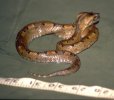You are using an out of date browser. It may not display this or other websites correctly.
You should upgrade or use an alternative browser.
You should upgrade or use an alternative browser.
Trouble down under….
- Thread starter 3 LINK
- Start date
Focalplane
Western Thunderer
When I worked in Venezuela I was told there are fifty species of snake. Forty eight are deadly poisonous and the other two will squeeze you to death. I always checked the loo bowl before sitting down!
Last edited:
midnightmiller
Active Member
Make's the case for higher track voltage !
john
john
When I was involved in a rattlesnake breeding programme at a zoo in Dorset [now long closed] we did consider putting a single O gauge line passing through the rear of one of the vivariums with small doors that rose and fell to allow the train through. Kind of perspective effect with the snakes in the foreground and the train in the 'distance'.
The thing that scuppered the idea was the adminstrative inconvenience of getting into the vivarium in the case of derailment!
Mind you in 25 years of involvement with them I was never bitten once, though I came close twice in my first two weeks helping there. You tend to learn very quickly where Western Diamonback rattlesnakes are concerned. Those guys give a whole new meaning to the word 'irritable'! Amazing creatures though on so many levels.
The thing that scuppered the idea was the adminstrative inconvenience of getting into the vivarium in the case of derailment!
Mind you in 25 years of involvement with them I was never bitten once, though I came close twice in my first two weeks helping there. You tend to learn very quickly where Western Diamonback rattlesnakes are concerned. Those guys give a whole new meaning to the word 'irritable'! Amazing creatures though on so many levels.
adrian
Flying Squad
When I was involved in a rattlesnake breeding programme at a zoo in Dorset [now long closed] we did consider putting a single O gauge line passing through the rear of one of the vivariums with small doors that rose and fell to allow the train through. Kind of perspective effect with the snakes in the foreground and the train in the 'distance'.

 Is this the royal "we". I just love the vision of the sales pitch to "the management", you know what we really need to get visitors in to see the snakes is a model railway running through the back of the vivarium!
Is this the royal "we". I just love the vision of the sales pitch to "the management", you know what we really need to get visitors in to see the snakes is a model railway running through the back of the vivarium!  Presumably it would have been King (cobra) hauling a rake of Pythons.
Presumably it would have been King (cobra) hauling a rake of Pythons.It would have been a plastic bodied SD40-2 which were around at the time and 2-3 cheapo box cars. It would of course have been a gimmick and a nod to several movies l can think of but we (the owner and staff) were also concerned that every train movement mighf get derailed, knowing the Western Diamondback’s tendency to strike at anything that moves
Focalplane
Western Thunderer
I was helping to survey some land with my real estate brother in law back in the 1980s. Location, Brazos River bottom, Fort Bend County, Texas. Bending over the level I was using, B-in-L casually reminded me there would be Wood Rattlers around. Just at this moment a shuffling sound on the ground behind me. I carefully turned slowly round to look.
Just a near blind Armadillo!
Just a near blind Armadillo!
Phew!I was helping to survey some land with my real estate brother in law back in the 1980s. Location, Brazos River bottom, Fort Bend County, Texas. Bending over the level I was using, B-in-L casually reminded me there would be Wood Rattlers around. Just at this moment a shuffling sound on the ground behind me. I carefully turned slowly round to look.
Just a near blind Armadillo!
Arun Sharma
Western Thunderer
A few years ago in Belize a passing Gurkha coming off patrol handed me a bottle of whisky empty[!] apart from this chap. This is a hog-nosed pit viper that his patrol had found in one of their trenches. They 'persuaded' it to slither into said bottle of whisky where no doubt it drowned albeit somewhat insensate.
 Venomous snake bites were not unknown in Belize and casevacs to Miami were usually required after stabilisation by the resident field surgical team..
Venomous snake bites were not unknown in Belize and casevacs to Miami were usually required after stabilisation by the resident field surgical team..
 Venomous snake bites were not unknown in Belize and casevacs to Miami were usually required after stabilisation by the resident field surgical team..
Venomous snake bites were not unknown in Belize and casevacs to Miami were usually required after stabilisation by the resident field surgical team..Focalplane
Western Thunderer
When I did fieldwork n S E Asia we always carried a snake bite kit. I never had to use it, thank goodness. This was back in the 1970s and Medivac didn’t exist. A jungle expert with the British Army in Malaysia told me most snakes moved away if you made enough vibration. One exception was the krait which would attack regardless.
Arun Sharma
Western Thunderer
The Fer de Lance [probably the largest of the Central American pit vipers] tends not to be discouraged by soldiers drifting through the undergrowth and will attack them. As you say, most other snakes hide in the presence of people.
Yes indeed, and it’s relative the Bushmaster too - up to 12’ long and an extremely fast mover through it’s habitat - hence the name. Since you refer to pit vipers above, it might be worth saying that this does not refer to any preference they might have for living in pits!The Fer de Lance [probably the largest of the Central American pit vipers] tends not to be discouraged by soldiers drifting through the undergrowth and will attack them. As you say, most other snakes hide in the presence of people.
It relates to a heat sensor known as the Loreal pit on each side of the head, set between and lower down than the nostril and eye. If any of you have seen the film Predator you will remember how the creature sees humans, with the warmer core in orange to red and with the extremities in blue! Well it’s kind of similar with all the snakes you have mentioned, including the largest group of pit vipers, the rattlesnakes. This enables them to strike pray accurately in darkness when the heat signature is the same through both pits.
The Loreal pit has been the subject of much study in decades gone by in connection with the development of heat seeking missiles.
We had a golden rule at the serpentarium that if carrying rattlers (or copperheads - the other pit vipers we had) in a knapsack, you should never let the sack brush against your leg. The occupant could all too easily sense your body heat and strike through the bag!
Finally all this reminds me of dear old Adrian Swain of ABS fame. He shared my passion for reptiles and we talked as much about those as we did about models! He always loved seeing whatever snakes l was involved with at the time.
JimG
Western Thunderer
One exception was the krait which would attack regardless.
That brings back memories for me of my late father. Before WW2 he worked abroad in the Middle East and Burma and he would tell my brother and I of some of his experiences. And of course we would want to know about the dangerous animals he might have seen. The one animal he did specially remark on was the krait when he was in Burma - he had a healthy respect for it.

Jim.
Focalplane
Western Thunderer
I never worked in the Louisiana swamps, thank goodness! But cottonmouths and copperheads were everywhere. I did see a large copperhead after heavy rain in Texas which is when they usually appear, hanging from trees. But I have a nice Cajun story to tell.
Two cajuns were in a flat bottomed metal boat in the Atchafalaya Swamp, west of New Orleans. A cottonmouth dropped from a tree into the boat. “Don’t worry!” said one, “I’ll get it.”
He pulled out his revolver, fired six shots at the snake and missed. Then the boat began to sink.
Two cajuns were in a flat bottomed metal boat in the Atchafalaya Swamp, west of New Orleans. A cottonmouth dropped from a tree into the boat. “Don’t worry!” said one, “I’ll get it.”
He pulled out his revolver, fired six shots at the snake and missed. Then the boat began to sink.
Focalplane
Western Thunderer
I don’t know why, but I keep remembering snake stories from days in the oil industry. Here are two related by area and outcome.
First, Dr Walter Blow, palaeontologist extraordinaire, was writing monographs on single cell foraminifera at the end of a long career which involved several years in Trinidad. He was a war hero, badly injured and so had a wooden leg fitted. While working in the swamps in central Trnidad he saw a fer de lance swimming toward him. The snake attacked and hit his leg, then swam away. You guessed, the snake chose the wrong leg.
Second, Peter Hardwick was general manager of BP Singapore when I arrived in 1974. He had worked in the Llanos area of Colombia where he had a field crew of locals. Again he was attacked by a fer de lance and bitten. However he survived, much to the surprise of the field crew. His explanation was that the snake had recently used up its venom on another attack. He was treated with awe from then on and could do no wrong!
First, Dr Walter Blow, palaeontologist extraordinaire, was writing monographs on single cell foraminifera at the end of a long career which involved several years in Trinidad. He was a war hero, badly injured and so had a wooden leg fitted. While working in the swamps in central Trnidad he saw a fer de lance swimming toward him. The snake attacked and hit his leg, then swam away. You guessed, the snake chose the wrong leg.
Second, Peter Hardwick was general manager of BP Singapore when I arrived in 1974. He had worked in the Llanos area of Colombia where he had a field crew of locals. Again he was attacked by a fer de lance and bitten. However he survived, much to the surprise of the field crew. His explanation was that the snake had recently used up its venom on another attack. He was treated with awe from then on and could do no wrong!





